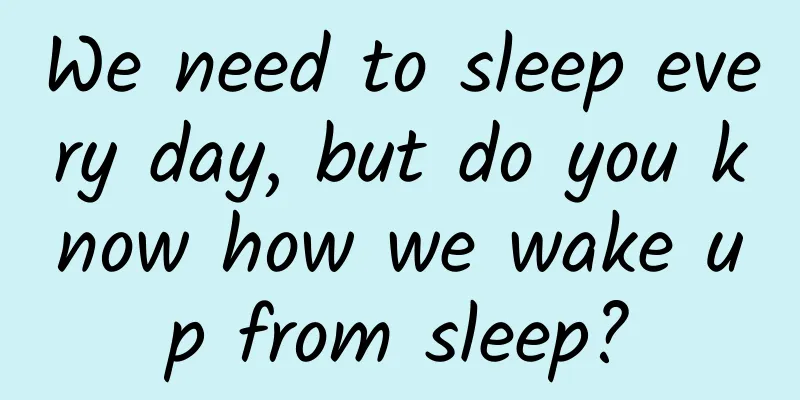We need to sleep every day, but do you know how we wake up from sleep?

|
Produced by: Science Popularization China Author: Qian Yu (Center for Excellence in Brain Science and Intelligence Technology, Chinese Academy of Sciences) Producer: China Science Expo Sleeping is a lifelong event. Sleeping time accounts for about 1/3 of our life. As one of the most important life activities of human beings, it plays a key role in cognition, immunity and physical health. But have you ever wondered how we wake up in the morning? Today I will take you to understand the neural mechanism of waking up from sleep. sleep (Photo source: veer photo gallery) It looks like I just slept, but my brain is actually very busy If we have to define sleep, we can define it as a natural, recurring physiological state , which is manifested by the disappearance of various conscious and active behaviors within a certain period of time every day, and is also a state of weakened response to external environmental stimuli. According to the characteristics of sleep, we can divide sleep into two types: rapid eye movement sleep (REM) and non-rapid eye movement sleep (NREM) . Non-rapid eye movement sleep can be further divided into N1, N2 and N3 stages, among which N1 stage is considered to be the transition stage between wakefulness and sleep. N2 stage is light sleep , which lasts throughout the sleep period. During this stage, the human body will experience changes such as muscle relaxation, slow heart rate and drop in body temperature. N3 stage is the deep sleep stage , which can also be called delta wave or slow wave sleep, which mainly occurs in the first third of the night's sleep time. At this time, the brain is in an unconscious state . If we are awakened in the deep sleep stage, we are likely to be unconscious for a few minutes, or even confused about the situation. As we age, the proportion of non-REM sleep gradually decreases, which is why older people usually sleep shorter hours and sometimes wake up in the middle of the night and become very alert, making it difficult to fall asleep again. After each non-rapid eye movement sleep stage N1-N3 ends, a rapid eye movement sleep follows. The REM sleep state is mainly driven by the sympathetic nervous system , including physiological characteristics such as rapid eye movement, respiratory variability and muscle twitching. This is also the sleep interval in which we dream. Since a whole night of sleep contains multiple REM sleep intervals, we will have multiple dreams. During REM sleep, we are easily awakened by surrounding noises because our sleep is relatively shallow. Infants have a higher proportion of REM sleep, so they need a quieter environment to sleep. Adults have a relatively lower proportion of REM sleep, so they have lower requirements for the environment. In 8 hours of sleep, the brain enters and exits the REM sleep period about 4 to 5 times. We must go through light sleep to enter deep sleep. Sometimes the reason why we can't wake up after sleeping for a long time is that we have been wandering in the light sleep state, while deep sleep is the key stage to restore physical strength, energy and consolidate memory. Various states of sleep (Image source: Reference [15]) How did we wake up? Every morning when we need to go to school or work, the warm and comfortable bed is the shackle that keeps us from getting up. Waking up naturally is the happiest thing, but usually people are woken up by a shrill alarm clock. This kind of stimulation is called strong external information input . People's perception of the outside world will be reduced during sleep. For example, they cannot hear the whispers of people around them when they are asleep, but strong external stimulation can still wake us up in various sleep stages. In addition to strong stimulation, waking up naturally is another way of awakening from sleep. Why do we wake up naturally? The reasons for waking up naturally can be attributed to two points: one is the effect of the biological clock , and the other is the "obsession" in our hearts . When we keep thinking about something before going to bed, such as going to a place you have always wanted to go or meeting a person you have always wanted to meet on the weekend morning (of course, excessive "obsession" may cause insomnia). The former may be due to the fact that the brain areas responsible for biological rhythms (such as the suprachiasmatic nucleus of the hypothalamus) activate the pro-wakefulness circuits in the brain in the morning, prompting us to wake up naturally; the latter is because some brain areas responsible for higher-level functions begin to work, thereby promoting wakefulness. Both will eventually end up in the awakening loop, so what is the underlying loop mechanism of awakening? The arousal circuit originates in the paramedian region of the midbrain and then branches into two parallel circuits: the dorsal pathway , which projects to the thalamus, and the ventral pathway , which innervates the hypothalamus, basal forebrain, and cortex. The dorsal pathway enables the thalamus to process signals related to sensation, motor responses, and cognition. Patients with thalamic damage are in a conscious but unconscious vegetative state. In contrast, patients with lesions of the ventral pathway often have difficulty staying awake and sleep longer than the average person. Increased total sleep has also been reported in patients with lesions of the paramedian thalamus. Normal wakefulness requires the joint action of the dorsal pathway and the ventral pathway. The generation of conscious content relies on the dorsal pathway to activate the signals generated by the thalamocortex, while the ventral pathway is essential for the behavioral state of wakefulness. Damage to the ventral pathway may make awakening impossible. Therefore, after being woken up by the alarm clock early in the morning, our brains go blank for a period of time and we become insensitive to many things. This short "downtime state" may be a manifestation of the dorsal pathway not being fully activated . Arousal-promoting circuit (Image source: Reference [15]) In addition to the two parallel circuits mentioned above that promote wakefulness and play different roles in the wakefulness process, neuromodulators also play an important role in wakefulness. For example, norepinephrine (NE) and dopamine (DA) released by monoamine neurons are important components of the wakefulness-promoting circuit. How to get a good night's sleep? 1. You can consume a certain amount of protein before going to bed. For example, you must have heard the common sense that a cup of hot milk can help you sleep. The sleep-aiding mechanism behind it is that a high-protein diet will promote intestinal cells to secrete a neuropeptide called CCHa1. This neuropeptide enters the brain and activates dopaminergic neurons, promoting their release of dopamine, inhibiting sleep and wakefulness, and thus improving sleep quality. Therefore, not only can a cup of hot milk before bed help you sleep, but increasing the protein content in your diet appropriately will also help you sleep better. However, you should avoid foods that are too greasy or difficult to digest. Friends who get up frequently at night should remember to drink less water before going to bed. High-protein diet promotes sleep (Image source: Reference [16]) 2. You can take a hot bath for less than 20 minutes within half an hour before going to bed to help us relax our muscles and increase our body temperature. After taking a bath, the body temperature drops and the brain's melatonin secretion increases, which makes you feel tired and more conducive to falling asleep. 3. Fix the time for getting up and going to bed to maintain a stable sleep cycle. Don't worry if you can't fall asleep. Relax. Paying too much attention to sleep itself and feeling nervous will have the opposite effect and will not be conducive to your sleep. 4. Close the curtains before going to bed and open them when you get up. Controlling the light intensity in the bedroom is conducive to stabilizing the rhythmic signals of the suprachiasmatic nucleus and pineal gland. Keep the bedroom temperature appropriate and minimize sound interference. Also, don’t sleep in on the weekends! References: [1]Herculano-Houzel S. Neuroscience. Sleep it out. Science. 2013;342(6156):316-317. doi:10.1126/science.1245798 [2]Tsoukalas I. The origin of REM sleep: A hypothesis. Dreaming. 2012; 22:253–83.10.1037/ a0030790 [3]Hirshkowitz M. Normal human sleep: an overview. Med Clin North Am. 2004;88(3):551-vii. doi:10.1016/j.mcna.2004.01.001 [4]Murphy PJ, Campbell SS. Nighttime drop in body temperature: a physiological trigger for sleep onset?. Sleep. 1997;20(7):505-511. doi:10.1093/sleep/20.7.505 [5]Giber K, Diana MA, Plattner V, et al. A subcortical inhibitory signal for behavioral arrest in the thalamus. Nat Neurosci. 2015;18(4):562-568. doi:10.1038/nn.3951 [6] Lewis LD, Voigts J, Flores FJ, et al. Thalamic reticular nucleus induces fast and local modulation of arousal state. Elife. 2015;4:e08760. Published 2015 Oct 13. doi:10.7554/eLife.08760 [7]Posner, J., Saper, C., Schiff, N., and Plum, F. (2007). Plum and Posner's Diagnosis of Stupor and Coma (New York: Oxford University Press). [8]Fuller, PM, Sherman, D., Pedersen, NP, Saper, CB, and Lu, J. (2011). Reassessment of the structural basis of the ascending arousal system. J. Comp. Neurol. 519, 933–956 [9]Ranson, S. (1939). Somnolence caused by hypothalamic lesions in the monkey. Arch. Neurol. Psychiatry 41, 1–23. [10]Bassetti C, Mathis J, Gugger M, Lovblad KO, Hess CW. Hypersomnia following paramedian thalamic stroke: a report of 12 patients. Ann Neurol. 1996;39(4):471-480. doi:10.1002/ana.410390409 [11]Gompf HS, Mathai C, Fuller PM, et al. Locus ceruleus and anterior cingulate cortex sustain wakefulness in a novel environment. J Neurosci. 2010;30(43):14543-14551. doi:10.1523/JNEUROSCI.3037-10.2010 [12]Carter ME, Brill J, Bonnavion P, Huguenard JR, Huerta R, de Lecea L. Mechanism for Hypocretin-mediated sleep-to-wake transitions. Proc Natl Acad Sci US A. 2012;109(39):E2635-E2644. doi:10.1073/pnas.1202526109 [13]Ferris MJ, España RA, Locke JL, et al. Dopamine transporters govern diurnal variation in extracellular dopamine tone. Proc Natl Acad Sci US A. 2014;111(26):E2751-E2759. doi:10.1073/pnas.1407935111 [14]Weissbourd B, Ren J, DeLoach KE, Guenthner CJ, Miyamichi K, Luo L. Presynaptic partners of dorsal raphe serotonergic and GABAergic neurons. Neuron. 2014;83(3):645-662. doi:10.1016/j.neuron.2014.06.024 [15]Scammell TE, Arrigoni E, Lipton JO. Neural Circuitry of Wakefulness and Sleep. Neuron. 2017;93(4):747-765. doi:10.1016/j.neuron.2017.01.014 [16]Titos I, Juginović A, Vaccaro A, et al. A gut-secreted peptide suppresses arousability from sleep [published correction appears in Cell. 2023 May 11;186(10):2273-2274]. Cell. 2023;186(7):1382-1397.e21. doi:10.1016/j.cell.2023.02.022 |
<<: In autumn, you must go to Kanas!
>>: Quantum teleportation: Will “transmitting objects through air” be possible?
Recommend
Why is the fifth day of the first lunar month called "Po Wu"? How to "Po"?
This article was reviewed by Shao Lin, a popular ...
How to do a good job in Zhihu promotion and traffic generation?
In fact, you only need to do these three things t...
How to build a local parent group with a retention rate of 95%?
In localized operations, because the subsequent p...
To solve the mystery of headphone cord entanglement, scientists put the cord in a box and shook it more than 3,000 times
Review expert: Luo Huiqian, Associate Researcher,...
Should B2B companies create video accounts and live broadcasts?
“Should we also do video accounts and live broadc...
What should you do if your phone falls on the subway tracks? First, don’t jump!
A netizen once asked sincerely, why are more and ...
Advertising data and cases in the home improvement industry
This article shares with you the investment ideas...
China Association of Automobile Manufacturers: A brief analysis of Chinese brand passenger car sales in April 2022
According to statistics and analysis by the China...
Shopping and short video apps, why can they always guess your favorites?
Have you ever experienced the pleasure of shoppin...
Landing page optimization method!
Looking at today's marketing situation, brand...
Yancheng Mini Program Investment Company, how much does the Big Turntable Mini Program cost?
How much does it cost to attract investment for t...
2015 App Operation and Promotion Strategy (Full Version)
The basic tone of the APP operation and promotion...
Different sleeping positions, different personalities? How do you sleep?
It is unreliable to judge a child's personali...
When the phone rings, I get anxious instantly! Why are people more and more afraid of answering the phone?
Leviathan notes: "If you don't do bad th...
Low traffic? Try these 6 low-cost marketing tactics!
Growth is a proposition that almost every operato...









